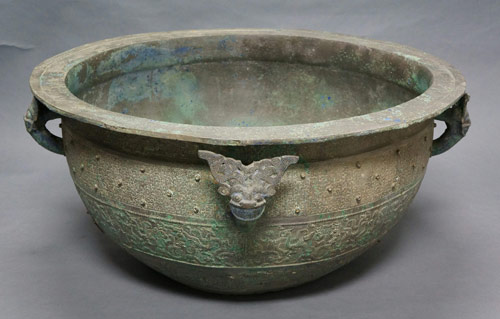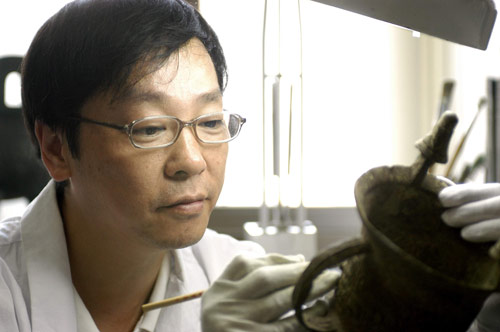
 'Taken 2' grabs movie box office crown
'Taken 2' grabs movie box office crown
 Rihanna's 'Diamonds' tops UK pop chart
Rihanna's 'Diamonds' tops UK pop chart
 Fans get look at vintage Rolling Stones
Fans get look at vintage Rolling Stones
 Celebrities attend Power of Women event
Celebrities attend Power of Women event
 Ang Lee breaks 'every rule' to make unlikely new Life of Pi film
Ang Lee breaks 'every rule' to make unlikely new Life of Pi film
 Rihanna almost thrown out of nightclub
Rihanna almost thrown out of nightclub
 'Dark Knight' wins weekend box office
'Dark Knight' wins weekend box office
 'Total Recall' stars gather in Beverly Hills
'Total Recall' stars gather in Beverly Hills
Relic restorer
Updated: 2012-11-15 09:56
By Zhang Kun (China Daily)
|
|||||||||
 |
|
The process of piecing together the 2,000-year-old bronze ware has taken Zhang Guangmin 16 years to complete. [Photo/China Daily] |
 |
|
Zhang Guangmin has worked as a restorer of bronzes at the Shanghai Museum for 37 years. |

He built a hemispherical framework before slowly piecing each piece together to restore it to its original shape. That part of the process took more than 10 years.
Every time after adding a new piece to the frame, restorers had to wait for a few months before adding another piece.
"Metals have their own strength and resilience," explains Zhou. "You have to make sure a piece is well settled in place, before patching on the next - that's the only way to make sure every piece fits perfectly. You can't rush things."
Zhang and his colleagues explored various ways of reconstructing the treasure, as there is no existing technology available. Bronze as a material for sacrificial vessels is unique to China.
"We went to many precision machinery fairs, and made use of jewelers' and even dentists' tools. You have to be inventive, and find solutions to your problems. You need to cut out the pattern in a perfect angle and join it with the existing part - it's like a jigsaw puzzle, but you have to create all the missing pieces," he says.
Zhang is thankful to the Art Conservation Project of Bank of America Merrill Lynch, an initiative to help conserve important works of art and cultural treasures all over the world. This year the project was in China for the first time.
Zhang got connected to the organization and acquired an ultra-sound knife - which was meant for jewelry designing.
"The knife made my work much easier, and helped me complete the restoration faster than expected," Zhang adds.
When the original pieces are reshaped, Zhang had to fill in the missing gaps with low-temperature welding, "to make sure it can be undone easily, if needed," Zhang says.
Then came the most difficult part: to reproduce the intertwining dragon patterns.
The patterns are intricate, purely handmade and more than 2,000 years old, on a surface of no more than 1 millimeter at its thinnest.
"It's not mechanical repetition. With every touch, our human hands will unavoidably leave traces of slight differences," Zhang explains.
Members of the public will be able to admire the finished work next year, after the bronze exhibition hall is refurbished at Shanghai Museum, says Chen Kelun, deputy director of Shanghai Museum.
Contact the writer at zhangkun@chinadaily.com.cn.
Most Viewed
Editor's Picks

|

|

|

|

|

|
Today's Top News
Health new priority for quake zone
Xi meets US top military officer
Japan's boats driven out of Diaoyu
China mulls online shopping legislation
Bird flu death toll rises to 22
Putin appoints new ambassador to China
Japanese ships blocked from Diaoyu Islands
Inspired by Guan, more Chinese pick up golf
US Weekly

|

|







